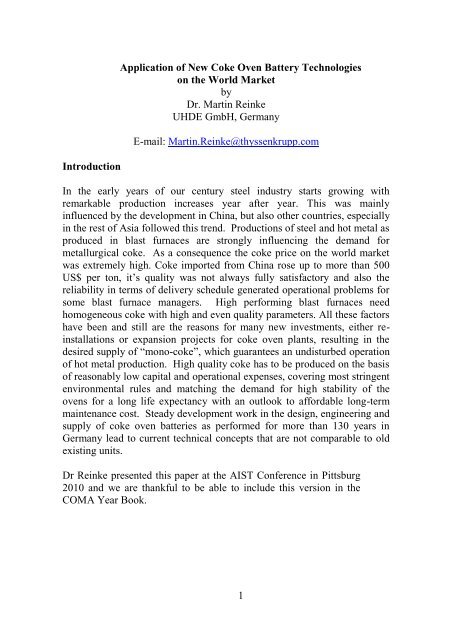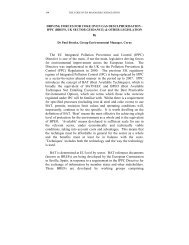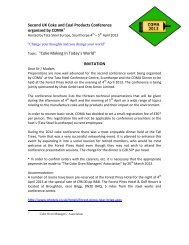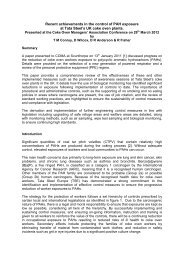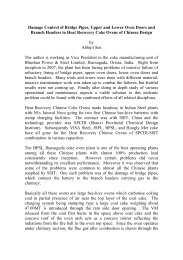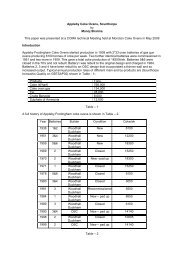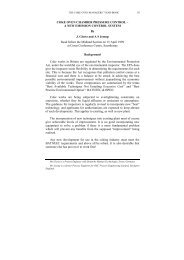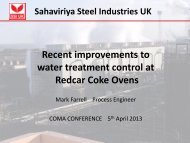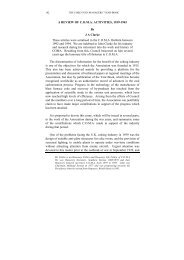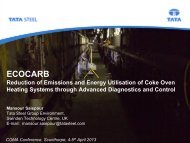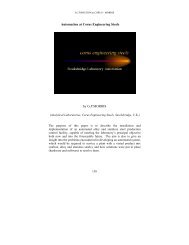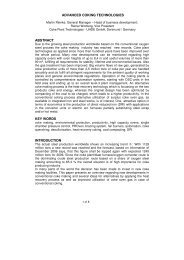THE YEAR-BOOK OF THE COKE OVEN - Coke-oven-managers.org
THE YEAR-BOOK OF THE COKE OVEN - Coke-oven-managers.org
THE YEAR-BOOK OF THE COKE OVEN - Coke-oven-managers.org
Create successful ePaper yourself
Turn your PDF publications into a flip-book with our unique Google optimized e-Paper software.
Introduction<br />
Application of New <strong>Coke</strong> Oven Battery Technologies<br />
on the World Market<br />
by<br />
Dr. Martin Reinke<br />
UHDE GmbH, Germany<br />
E-mail: Martin.Reinke@thyssenkrupp.com<br />
In the early years of our century steel industry starts growing with<br />
remarkable production increases year after year. This was mainly<br />
influenced by the development in China, but also other countries, especially<br />
in the rest of Asia followed this trend. Productions of steel and hot metal as<br />
produced in blast furnaces are strongly influencing the demand for<br />
metallurgical coke. As a consequence the coke price on the world market<br />
was extremely high. <strong>Coke</strong> imported from China rose up to more than 500<br />
US$ per ton, it’s quality was not always fully satisfactory and also the<br />
reliability in terms of delivery schedule generated operational problems for<br />
some blast furnace <strong>managers</strong>. High performing blast furnaces need<br />
homogeneous coke with high and even quality parameters. All these factors<br />
have been and still are the reasons for many new investments, either reinstallations<br />
or expansion projects for coke <strong>oven</strong> plants, resulting in the<br />
desired supply of “mono-coke”, which guarantees an undisturbed operation<br />
of hot metal production. High quality coke has to be produced on the basis<br />
of reasonably low capital and operational expenses, covering most stringent<br />
environmental rules and matching the demand for high stability of the<br />
<strong>oven</strong>s for a long life expectancy with an outlook to affordable long-term<br />
maintenance cost. Steady development work in the design, engineering and<br />
supply of coke <strong>oven</strong> batteries as performed for more than 130 years in<br />
Germany lead to current technical concepts that are not comparable to old<br />
existing units.<br />
Dr Reinke presented this paper at the AIST Conference in Pittsburg<br />
2010 and we are thankful to be able to include this version in the<br />
COMA Year Book.<br />
1
Discussion<br />
Driving Forces for New Investments<br />
The most important influences are the situation on the coke market, the age<br />
of existing plants in connection with considerations referring to medium-<br />
and long-term cost development of maintenance cost. In case of new<br />
batteries to be built capital and operation expenses are taken as a basis for<br />
decisions on technical concepts. Last but not least more and more stringent<br />
environmental requirements have to be taken into account, which<br />
consequently leads to the installation of coke <strong>oven</strong> batteries providing most<br />
modern technologies in this regard, too.<br />
<strong>Coke</strong> Market<br />
A strong increasing demand for coke is indirectly demonstrated in figure 1.<br />
An amount of more than 67% of oxygen steel, which is based on hot metal<br />
production in blast furnaces, is a clear indication that this classical<br />
production route keeps its dominant role. In relation to the growth of steel<br />
production as shown here, the annual amount of coke produced rose from<br />
350 million mt in 2003 worldwide to more than 540 million mt in 2008.<br />
Demand and availability of coke during this period was not completely<br />
outbalanced which led to the well known development of the coke price on<br />
the spot market as illustrated in figure 2. It shows tremendous values still<br />
in 2008 with a strong decrease after the beginning of the crisis. The price<br />
FOB China is kept thereafter on a constant value, which obviously<br />
represents an artificial figure, keeping in mind that the amount of exported<br />
coke from China has dropped down to some 10-thousand tons of coke per<br />
month in comparison to average values of about 1.2 million tons per month<br />
in the foregoing period. A recovery of the market is visualized by the<br />
increasing coke price CFR Europe, which represents a realistic relation<br />
between demand and availability and also the Chinese coke price is<br />
increasing at the beginning of 2010, despite the fact that only small portions<br />
have been exported.<br />
2
600<br />
500<br />
400<br />
300<br />
200<br />
100<br />
0<br />
1600<br />
1400<br />
1200<br />
1000<br />
800<br />
600<br />
Oxygen steel<br />
Electric steel<br />
Open hearth steel<br />
Thomas steel<br />
400<br />
200<br />
30.7 %<br />
0<br />
2.1 %<br />
1970 75 1980 85 1990 95 2000 2005<br />
Source : Stahlzentrum / VDEh - Düsseldorf<br />
3<br />
67.2 %<br />
Figure 1 World Crude Steel Production by Process (mill. mt /<br />
year) 1<br />
US $ / t<br />
800<br />
<strong>Coke</strong> export China Mill t/month<br />
Mill t/month<br />
1,8<br />
700<br />
1,6<br />
FOB China<br />
CFR Europe<br />
2005 2006 2007 2008 2009 2010<br />
Figure 2 <strong>Coke</strong> Prices (US$ / mt) and <strong>Coke</strong> Export ex<br />
China (mill. mt / month) 2<br />
1,4<br />
1,2<br />
1<br />
0,8<br />
0,6<br />
0,4<br />
0,2<br />
0
Age of the Production Units<br />
Since 2003 European suppliers of coke plants have realized order intakes<br />
for approx. 30 mill. mt/year in total, reflecting 21 million mt for reinvestments<br />
and 9 million mt for extensions. Only re-investments have<br />
taken place in Japan within 8 projects for approx. 5 million mt. This is<br />
caused by the comparably high age of Japanese plants with more than 36<br />
years on average in comparison to the worldwide average of approx. 26<br />
years. Due to intensive preventive maintenance coke <strong>oven</strong> batteries in<br />
Japan are of an extremely high age. This is illustrated in figure 3 showing<br />
the age distribution with almost 80% of <strong>oven</strong>s older than 30 years.<br />
2000<br />
1600<br />
1200<br />
800<br />
400<br />
0<br />
Number of <strong>oven</strong>s<br />
2.6 %<br />
4.2 %<br />
14.0 %<br />
< 20 20 - 25 25 - 30 30 - 35 35 - 40 > 40<br />
Years Takahashi Miwa / NSC, 4th ICSTI, Osaka, November 2006<br />
4<br />
39.5 %<br />
33.7 %<br />
Figure 3 Age distribution of Japanese coke <strong>oven</strong> batteries 3<br />
Decisions for High-Capacity Ovens<br />
(Capital and Operation Cost/Lifetime)<br />
6.0 %<br />
The development of high-capacity <strong>oven</strong>s is illustrated in figure 4. Starting<br />
with less than 10 mt per charge and comparably small chamber volumes in<br />
1900 the modern high capacity <strong>oven</strong>s with more than 90 m³ volumes are<br />
producing more than 50 mt per <strong>oven</strong>.
The advantages of such big chamber volumes are the reduction of capital<br />
and operation cost, optimization of environmental issues and the extension<br />
of lifetime. A comparison of these items is shown in table 1. All figures<br />
refer to a coke production of 2 million mt / year with typical <strong>oven</strong> heights<br />
of 4.3m respectively 6m and common volumes in comparison to 7.6m high<br />
<strong>oven</strong>s with a volume of 76m³. By applying the 7.6m-concept a reduction of<br />
capital cost is influenced by less <strong>oven</strong> units, less space on site and less sets<br />
of <strong>oven</strong> machines required. Less operation teams are required, which leads<br />
to an optimization of operation cost. Even more than 2 million mt of coke<br />
can be produced with on set of machines and one operation team,<br />
demonstrated at coking plant Schwelgern producing more than 2.6 million<br />
per year since 2003 for the blast furnaces of ThyssenKrupp Steel in<br />
Duisburg, Germany 4 . The specific manpower at Schwelgern counts to 106<br />
people per million mt. The former batteries produced the same amount of<br />
coke with a specific manpower of 336 people per million mt. In a longterm<br />
consideration it is also the expected lifetime of a battery that takes an<br />
influence on the cost situation.<br />
60<br />
50<br />
40<br />
30<br />
20<br />
10<br />
0<br />
1900<br />
tons of coke per <strong>oven</strong><br />
13 m³<br />
32 m³<br />
1920<br />
1940<br />
39 m³<br />
1960<br />
5<br />
53 m³<br />
1980<br />
76 m³<br />
2000<br />
94 m³<br />
useable chamber volumes<br />
Figure 4 Development of Chamber Volumes - History
Oven height<br />
Number of batteries<br />
Number of <strong>oven</strong>s<br />
Oven width<br />
Useable volume p. <strong>oven</strong><br />
Numb. of pushes/charges p. day<br />
Total length of sealings<br />
(doors, standpipes, charging holes)<br />
Required space for the batteries<br />
Sets of <strong>oven</strong> machines<br />
2<br />
3<br />
5<br />
Operation teams 1<br />
2<br />
3<br />
Typical number of pushes per <strong>oven</strong> during its lifetime :<br />
World average / Maximum<br />
12,000 15,000<br />
Oven width : 450 mm<br />
Coking time : 20 hr<br />
Pushes per <strong>oven</strong> :<br />
per day : 1.2<br />
per year : 438<br />
7.6 m 6.0 m 4.3 m<br />
2 4 5<br />
140 220 325<br />
590 mm 450 mm 450 mm<br />
76 m³ 34 m³ 20 m³<br />
135 300 520<br />
4.8 km 6.0 km 6.5 km<br />
40,000 m 2<br />
Oven width : 590 mm<br />
Coking time : 27 hr<br />
Pushes per <strong>oven</strong> :<br />
per day : 0.9<br />
per year : 324<br />
Lifetime per <strong>oven</strong> ( average / maximum )<br />
27 / 34 years 37 / 46 years<br />
6<br />
50,000 m 2<br />
Table 1 Comparison for 2 million mt of <strong>Coke</strong> Per Year<br />
55,000 m 2<br />
The extended lifetime of a battery with high-capacity <strong>oven</strong>s in comparison<br />
to a common design is illustrated in figure 5. A typical number of<br />
operation cycles per <strong>oven</strong> within the lifetime of a battery is 12,000 on<br />
average with maximum figures of approx. 15,000. Common <strong>oven</strong>s having<br />
a typical chamber width of 450mm and a coking time of 20h are pushed 1.2<br />
times a day with 438 pushes per year. High capacity <strong>oven</strong>s with a chamber<br />
width of 590mm have 0.9 pushes per day and 324 pushes per year. This<br />
leads to a total lifetime of 27/34 years of the common batteries in<br />
comparison to 37/46 years for the high capacity units.<br />
Figure 5 Different lifetimes of batteries
Environmental issues<br />
The comparison in table 1 indicates a general better environmental situation<br />
with the application of high-capacity <strong>oven</strong>s, generated by less pushing and<br />
charging per day as well as by a reduced total length of sealing elements at<br />
the <strong>oven</strong> closures, followed by less visible emissions.<br />
A further and high efficient improvement of this emission behavior can be<br />
achieved by applying the PROven ® - system, which represents a pressure<br />
control system for each individual <strong>oven</strong> of a coke <strong>oven</strong> battery. Its general<br />
function is illustrated in figure 6. The variable gas pressure<br />
Coking Chamber<br />
variable pressure<br />
during coking to be<br />
controlled by<br />
PROven<br />
PC<br />
variable flow<br />
resistance<br />
constant and low pressure<br />
in the coking chamber<br />
with PROven<br />
7<br />
Collecting<br />
Main<br />
approx.<br />
-25 mm w.c.<br />
Figure 6 General Function of the PROven ® - System, a<br />
Pressure Control for Each Individual Oven<br />
inside the <strong>oven</strong> chamber is compensated by a variable and controlled flow<br />
resistance, installed in the standpipe of each <strong>oven</strong> 5 . The collecting main<br />
pressure is kept under a constant suction (typical -25 mm W.C.). By<br />
applying additional fine tunings of the set points for the pressure control the<br />
gas pressure inside the <strong>oven</strong> is kept on a low and constant positive level.<br />
This results in low fugitive emissions at the doors and all other <strong>oven</strong><br />
closures and prevents air ingress at the doors into the <strong>oven</strong>s, avoiding<br />
damage of the refractory material by overheating charging emissions, too,<br />
are reduced drastically, since the full suction in the collecting mains can be<br />
used for transferring the charging gases to the raw gas system.
The first development of PROven ® - was carried out by the company DMT<br />
in Essen, Germany 6 . In cooperation with Uhde the system was developed<br />
for technical application. In total it took about 10 years until the first coke<br />
<strong>oven</strong> batteries without any additional provisions, such as high pressure<br />
water aspiration have been installed at the Schwelgern coking plant in<br />
Germany. The history of the development is shown in table 2, indicating<br />
its technical maturity.<br />
1991 - 1994 1995 - 1997 1997 - 1999 1999 - 2003<br />
R & D<br />
at DMT<br />
semi-technical<br />
research<br />
+<br />
assignation of<br />
patent<br />
Testing at<br />
5 <strong>oven</strong>s of<br />
coking plant<br />
August<br />
Thyssen (ATH)<br />
4m-high<br />
chambers<br />
30 <strong>oven</strong>s<br />
4m-chambers<br />
same battery<br />
(ATH)<br />
+<br />
DMT grants<br />
Uhde an<br />
exclusive<br />
license<br />
8<br />
6m-Battery<br />
ATH at<br />
52 <strong>oven</strong>s<br />
(DMT+Uhde)<br />
+<br />
2003 :<br />
2x70 <strong>oven</strong>s<br />
Schwelgern<br />
Table 2 10 years development of the PROven ® - system<br />
After the commissioning of PROven ® at Schwelgern many other<br />
applications have been realized world wide, which is also shown in table 3.<br />
In total 33 batteries comprising more then 2000 <strong>oven</strong>s are under contract<br />
with a different status of realization. Likewise, existing batteries under<br />
operation have been and, respectively, will be equipped with this system.<br />
The contract for the battery in the USA is on hold, resulting from influences<br />
of the crisis. In this connection it should be mentioned, that the EPA has<br />
acknowledged this technology as an alternative to the heat-recovery type of<br />
<strong>oven</strong>s due to its convincing environmental features.
Contracts for the PROven ® - System<br />
Country Oven height<br />
No. of<br />
batteries<br />
9<br />
No. of<br />
<strong>oven</strong>s<br />
Mio t of coke<br />
per year<br />
New batteries<br />
Germany 8.4 m 2 140 2,6<br />
China 7.6 m 12 840 12,0<br />
S.-Korea 7.6 m 8 440 6,0<br />
6.7 m 1 75 0,8<br />
Existing batteries<br />
Brazil 6.0 m 3 105 1,1<br />
6.6 m 3 147 1.8<br />
Options for new batteries<br />
S.-Korea 7.6 m 2 120 1,6<br />
Germany 7.8 m 1 70 1,1<br />
USA 6.1 m 1 85 0,9<br />
Total<br />
33 2022 26,1<br />
Table 3 Acceptance of PROven ® Worldwide<br />
Installation of New Production Capacities<br />
One of the results has already been shown in connection with the<br />
installation of PROven ® at new and existing batteries. The general trend<br />
with regard to the type of batteries moves strongly into the direction of<br />
batteries comprising high-capacity <strong>oven</strong>s, clearly influenced by the<br />
advantages as indicated above. The first step was the dismantling of the<br />
former coking plant “Kaiserstuhl”, located in Dortmund, Germany, with a<br />
rebuild of all facilities in Yangkuang, China. This happened in the period<br />
from 2003 to 2005, followed by many new batteries of this type in China.<br />
In total approximately 14 million mt of coke production capacity has and,<br />
respectively, will be installed in this strong growing country. Location and<br />
production figures are illustrated in figure 7.
WUGANG<br />
TISCO<br />
Two<br />
coke <strong>oven</strong> batteries<br />
7.6 m height<br />
2 million tpy<br />
Two<br />
coke <strong>oven</strong> batteries<br />
7.6 m height<br />
2 million tpy<br />
Beijing<br />
SHOUGANG / Caofeidian<br />
Shanghai<br />
MAGANG<br />
SHAGANG<br />
Two<br />
coke <strong>oven</strong> batteries<br />
7.6 m height<br />
2 million tpy<br />
10<br />
Four<br />
coke <strong>oven</strong> batteries<br />
7.6 m height<br />
4 million tpy<br />
YANKUANG<br />
Relocation Kaiserstuhl<br />
Two<br />
coke <strong>oven</strong> batteries<br />
7.6 m height<br />
2 million tpy<br />
Figure 7 Installation of Batteries With High Capacity<br />
Ovens in China – 14 million mt/a in Total<br />
This development also had an influence on other markets, as shown in<br />
figure 8. Actually 4 batteries each of this type are under construction<br />
and/or have entered into the commissioning phase in South Korea, that<br />
means for POSCO in Gwang Yang and for Hyundai Steel in Dangjin,<br />
respectively. A second option for another two batteries for Hyundai Steel is<br />
under consideration. In all cases complete gas treatment plants for the<br />
whole production belong to the scope of supply.<br />
Several conventional coke <strong>oven</strong> batteries with normal <strong>oven</strong> volumes have<br />
been installed in Asia and other countries, comprising all remaining new<br />
technology items, such as equipment for environmental protection.<br />
Situation After the Crisis<br />
From about 1.4 billion mt of crude steel in 2006 the annual production<br />
dropped down to 1.2 billion mt in 2009. Accordingly the coke production<br />
was influenced due to the reduced demand. <strong>Coke</strong> <strong>oven</strong> batteries have been<br />
set in idle-hot or in some extreme cases they have been shut down totally.
Four<br />
coke <strong>oven</strong> batteries<br />
240 <strong>oven</strong>s<br />
7.6 m height<br />
3.2 million tpy<br />
incl. gas treatment<br />
+ option :<br />
Two<br />
coke <strong>oven</strong> batteries<br />
120 <strong>oven</strong>s<br />
7.6 m height<br />
1.6 million tpy<br />
incl. gas treatment<br />
HYUNDAI STEEL CORP:<br />
POSCO - GWANGYANG:<br />
Figure 8 New high capacity <strong>oven</strong>s in South Korea<br />
11<br />
Four<br />
coke <strong>oven</strong> batteries<br />
200 <strong>oven</strong>s<br />
7.6 m height<br />
2.8 million tpy<br />
incl. gas treatment<br />
With regard to the situation for new projects, delays, terminations and onhold<br />
settings were the result.<br />
Some examples:<br />
The contract for the second battery of Hüttenwerke Krupp Mannesmann<br />
(HKM), located in Duisburg, Germany was placed on hold. The<br />
engineering for 70 high-capacity slot-type <strong>oven</strong>s for a production of 1.1<br />
mill t/year has been finalised and the preparation site works have been<br />
stopped. So far there is no further progress visible.<br />
In the USA two contracts have been influenced. One was for US-Steel<br />
Clairton Works and has been terminated. Uhde Dortmund as technologysupplier<br />
for Uhde Corporation of America (UCA) has prepared a certain<br />
amount of the engineering work for the rebuild of Battery C, comprising 85<br />
slot-type <strong>oven</strong>s with a height of 6.1m and providing a production capacity<br />
of 0.9 mill t/year. After a long period this was the first contract for a<br />
conventional coke <strong>oven</strong> battery in the US due to the fact that the EPA has<br />
acknowledged the installation of PROVen ® the single <strong>oven</strong> pressure control<br />
system at this battery as an alternative to the environmentally friendly heatrecovery<br />
coking technology.<br />
The second project in the US to be mentioned is kept on hold. A leading<br />
steel company has placed an order to UCA for a heat-recovery coking plant,
comprising 140 <strong>oven</strong>s and prepared for a production of 0.9 mill t/year,<br />
based on a coal compacting technology developed by Uhde. In this case,<br />
too, UCA has placed an order to the German technology supplier Uhde<br />
Dortmund. Certain engineering packages have been finished and the<br />
delivered equipment has been taken on stock. Further progress is still open.<br />
However the increasing production figures for steel worldwide are a strong<br />
indication that in the field of new investment for coking plants, too, a<br />
positive market can be expected. Likewise, the coke price has shown an<br />
increasing trend by the beginning of 2010.<br />
Summary and Outlook<br />
Before the economic crisis, accompanied by critical developments in the<br />
iron and steel industry, conditions for new investments world wide, and in<br />
the field of coke making, too, were excellent. Many new plants have been<br />
installed either as substitutions of existing old facilities or as extension<br />
projects covering the increasing demand for steel, hot metal and<br />
consequently coke. Long lasting work of development for the coke making<br />
technologies could be materialised at many places in the world, especially<br />
in China and in the rest of Asia. Efforts for optimizing specific cost for<br />
investment and operation can be covered by installing batteries with highcapacity<br />
<strong>oven</strong>s. Batteries of this type have been installed for a total<br />
production of approximately 20 million t/year since 2003. Likewise, the<br />
environmental situation will be improved by the operation of high capacity<br />
<strong>oven</strong>s, since for a certain coke production per year less charging- and<br />
pushing cycles have to be carried out. In addition this takes a positive<br />
effect on the lifetime to be expected for these production units. A big jump<br />
forward in terms of environmental optimisation was realised by the<br />
development of a single chamber pressure control system, called PROven ® ,<br />
which brings the fugitive and visible emissions of a coke <strong>oven</strong> battery down<br />
to almost zero, including charging emissions. The development of this<br />
system within a period of 10 years stands for a technical mature technology.<br />
Its application on more than 2000 <strong>oven</strong>s proves its acceptance wide.<br />
12
References<br />
1. Private communication, Stahlzentrum, VDEh-Düsseldorf, Germany<br />
2. A. Jones, <strong>Coke</strong> Market Report, Analysis of the Global <strong>Coke</strong> &<br />
Metallurgical Coal Market, www.resource-net.com<br />
3. T. Miwa, Development if recent iron-making technologies in Japan, The<br />
4 th International Congress on the Science and Technology of Ironmaking,<br />
November 26-30, 2006 Osaka, Japan, Proceedings pp. 26-32<br />
4.K. Hofherr; Improved Environmental Protection through Modern <strong>Coke</strong><br />
Plant Technology at the New Plant in Schwelgern; <strong>Coke</strong> Making<br />
International, Vol.13, 1/2001, pp 39-45<br />
5. H. J. Giertz, New process to avoid emissions: constant pressure in coke<br />
<strong>oven</strong>s, Ironmaking Conf. Proc. 54, 1995, 439-445 (Nashville)<br />
6.Operation Experience Gained with PROven ® (Pressure Regulated Oven<br />
System) in the New Schwelgern <strong>Coke</strong> Oven Plant, Proc. 5th European<br />
<strong>Coke</strong> and Ironmaking Congress, June 12-15, 2005, Stockholm,<br />
13


